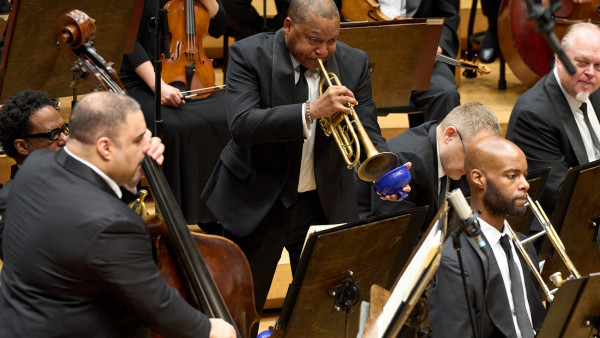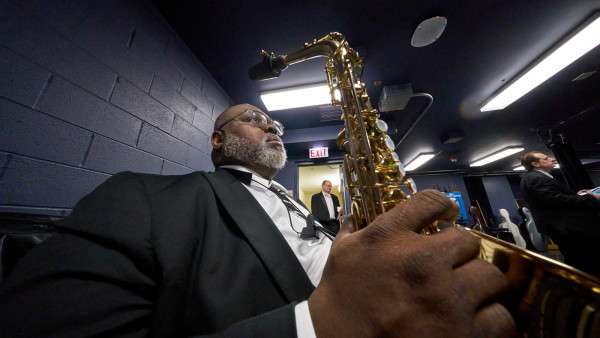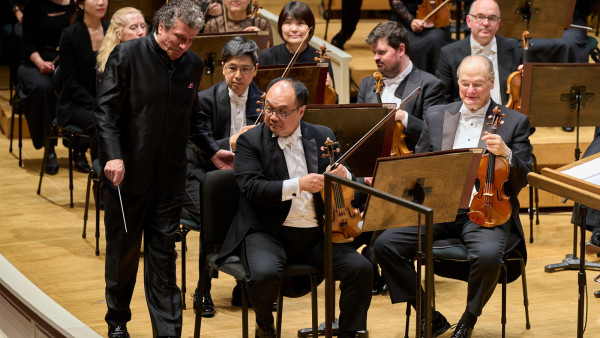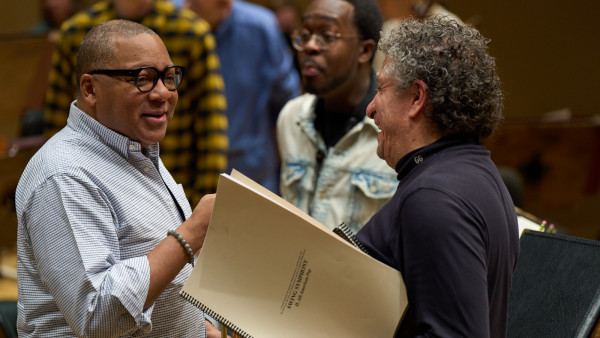Review: Wynton Marsalis’ Jazz at Lincoln Center Orchestra in a spirited, if uneven, collaboration with the CSO
This week, musicians of the Chicago Symphony get to do something they typically don’t during their regularly scheduled subscription concerts: be part of the audience.
Then again, it’s not every day the CSO shares a crammed Orchestra Hall stage with an ensemble like the Jazz at Lincoln Center Orchestra, led by trumpeter and composer Wynton Marsalis. Marsalis and the JLCO are annual visitors to Symphony Center’s jazz series and have memorably, if infrequently, linked up with our own house band for performances.
Thursday night followed the recipe of earlier treats: perform a well-known suite in the classical canon, but trade off the familiar symphonic movements with arrangements for big band. Duke Ellington and Billy Strayhorn’s treatment of Edvard Grieg’s “Peer Gynt” suite was the highlight of the first JLCO/CSO concert back in 1999. (It was reprised for the 2004 Symphony Hall under Sir Andrew Davis, who died last week.) Their last joint concert, in 2017, featured the Mussorgsky/Ravel “Pictures at an Exhibition,” with jazzy rearrangements by JLCO members.
This time, the two orchestras went for selections from Prokofiev’s “Romeo and Juliet,” again with world-premiere reinterpretations from the JLCO. After a CSO-only intro on “The Montagues and the Capulets,” the JLCO comped on the playful tutti theme to “The Child Juliet” behind solos — scampering in the original, swinging in saxophonist Sherman Irby’s arrangement. JLCO’s “Child Juliet” hands its sweeping cello solo to baritone saxophone Paul Nedzela, whose sexy, sliding reimagining drew grins from some of the CSO musicians, sitting tacet onstage. That admiration went both ways: when the CSO took over, for the “Minuet,” “Romeo and Juliet” and “Death of Tybalt” movements, JLCO bandmembers’ necks craned to admire the CSO’s symphonic surround sound.
Irby’s arrangement was perhaps most faithful to Prokofiev’s score, but in all the JLCO movements, one caught glimpses of their arrangers’ musical personalities. Bassist Carlos Henriquez bounced between Latin polyrhythms and straight-ahead swing in his twist on the “Folk Dance.” Trombonist Chris Crenshaw’s “Masks” amplified that movement’s harmonic ambiguity and flaunted the JLCO’s own trumpet pyrotechnician in Rob Kizor, whose lead lines dominated wherever they appeared. By the time the CSO capped things off with “Death of Tybalt,” that cavorting movement seemed not at all far removed from the clockwork cohesion and rhythmic integrity of big-band music.
For all the dialogue between these great ensembles, however, like its other co-billings, the CSO and JLCO rarely played together for this concert. Of the two ensembles, the JLCO came off much tighter in its two short-but-sweet Ellington selections, “Big Fat Alice’s Blues” (gilded by Irby’s warm-going-on-hot alto sax solo, at turns heartfelt and humorous) and a rhythm-only “Dancers in Love,” than the CSO did in its own showcases.
Guerrero’s easygoing, cheery podium manner meshed well with a fun program like this one. Musically, though, he could be light on details, especially where balance was concerned. His “Chairman Dances,” an outtake from John Adams’s 1987 opera “Nixon in China,” cranked up all the knobs on the CSO’s orchestral console, as though to see how far they can go. The detailed rhythmic layers hit listeners at full blast, no problem, but with little mind to their assembly. Parts of the “Romeo and Juliet” suite — like the percussion-drenched opening to “The Montagues and the Capulets” — and a searing Shostakovich’s Suite for Variety Orchestra, arranged by Levon Atovmyan from the composer’s incidental music scores, mostly left the same pops-without-polish impression.
For as flashy as that Shostakovich suite could be, it ferried some great reciprocal ensemble work between a JLCO saxophone quartet and the CSO. “Dance 2” ends with that section’s lovely, snaking handoff to the woodwinds, and Irby and clarinetist John Bruce Yeh sprinted side-by-side in their unison runs during the “Little Polka.”
But for the full ranks of both orchestras to link up, at last, one had to wait for the concert finale: “All-American Pep,” a lively-turned-lyrical movement from Marsalis’s “Swing” Symphony (2010). It shaped up quickly from a scattered start, boosted by phenomenal solos from CSO principal flutist Stefán Ragnar Höskuldsson and, again, bari player Nedzela. The movement is great fun, but it also ended the JLCO/CSO’s last joint concert, in 2017. Why not something different — say, any one of the “Swing” Symphony’s other six movements?
es before). Maybe next time — and ideally, “next time” won’t come seven years from now.
“CSO x Jazz at Lincoln Center Orchestra with Wynton Marsalis” repeats 7:30 p.m. Apr. 26 and 27, Symphony Center, 220 S. Michigan Ave., tickets $75-400, cso.org
by Hannah Edgar
Source: Chicago Tribune




